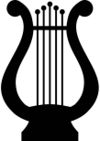Dance in Ancient Rome
The Salii and the Arval Brethren were ancient Roman organizations of priests who danced at religious festivals. Dance was used to thank the gods, and it held an important place in the Dionysia. Before battles, Roman soldiers could hold dances to honor the god Mars. Music and dancing was also used to ensure the efficacy of sacrifices. Varro, a Roman author, wrote that dance was used in religious festivals as "no part of the body should be debarred from religious experiences." Dance was a popular form of entertainment in ancient Rome. Ovid describes drunk people dancing and singing in the streets during festivals such as the Anna Perenna. The Romans would hire dancers from conquered nations or train slaves to dance. Female dancers, known as crotalisterias, danced using bells and clappers. Another popular kind of dance was tripudia, which were three-foot dances.
Pantomimists were popular in ancient Roman theatre. They wore cloaks, masks with closed mouths, and costumes. Plutarch described ancient Roman pantomimes as twisting, leaping, and standing like a statue. He also wrote that criminals may be condemned to dancing in festivals. Dancing was used as way to accentuate beauty and could be erotic. Private dance schools trained ancient Roman aristocrats. Improper dance in ancient Rome was defined as being un-Roman. Foreign dancing styles were disliked. Elagabalus was heavily scrutinized for his usage of foreign dances. Cornelius Nepos associated dance and music with ancient Greek culture and treated it with disdain. Cicero stated that no sober person would dance unless they were a "lunatic." He likely did not object to the usage of dance as entertainment but instead considered it to be beneath the upper-class Romans. Cicero may have believed that it should be relegated to only lower-class professional dancers. It is also possible he was exclusively referring to erotic or foreign dancing. Scipio Aemilianus criticized dancers for "improper display of their bodies."
| Articles related to: Dance and/or Competitive dance |
|---|
|
|
|
External links
- Ensemble Kérylos, a music group led by scholar Annie Bélis and dedicated to the recreation of ancient Greek and Roman music.
- Musica Romana, musicarchaeology, scientific review of ancient Roman music as well as performances, bibliography and descriptions for instruments and notations online (English and German).
- Thesaurus Musicarum Latinarum (TML), an evolving database of the entire corpus of Latin music theory written during the Middle Ages and the Renaissance.
- Synaulia, dedicated to the reconstruction of historical musical instruments, sound theatre, dance on the basis of ethnology.
- Greek origins of Roman music
Chat rooms • What links here • Copyright info • Contact information • Category:Root
